 Examine
Examine
 Verify
Verify
 Educate
Educate
 Assist
Assist
 Liberate
LiberateInternational Churches of Christ (ICC) (ICOC)
 Boston Movement
Boston Movement
 Crossroads
Movement
Crossroads
Movement Research
 Examine
Examine
 Verify
Verify
 Educate
Educate
 Assist
Assist
 Liberate
Liberate
International
Churches of Christ (ICC) (ICOC)  Boston Movement
Boston Movement
 Crossroads
Movement
Crossroads
Movement

"We need to have a conviction. If our churches are not growing, it's sin. ”
-- Kip McKean; see full quote
Early in 2002, ICC-watchers were surprised with a new source of information on the movement: the organization's complete 1999-2001 statistics. This article analyzes these numbers, makes new calculations and uncovers several trends in the ICC.
[Note: This article originates from RightCyberUp.org. All non-REVEAL links will open in a new window. ]
The source was unexpected -- the ICC itself had posted the statistics to pages of the UpCyberDown.org website. Probably intended for ICC leaders, these pages were nevertheless indexed in the site's seach engine and available to any surfer. They were soon taken down after the pages were publicly announced on Delphi's ICC Discussion Forum. Today, these numbers are posted online at the London former members' site TOLC.org.
These numbers may come as a surprise to those who have heard the ICC's glowing publicity about its growth, baptism rates, and statistics as a validation of God's working thru the movement. Instead, these numbers will show that the one-time dream of being a "multiplying" movement seems to be escaping the ICC. Whether the ICC has started to collapse on itself or is merely suffering a temporary setback remains to be seen.
The ICC's biggest obstacle to growth is quite simply its high "fallaway" rate -- the number of members leaving the group (1). By 1995, ICC spokesman Al Baird acknowledged the ICC's high turnover rate, saying that at that time two people left for every three that joined.
But never before have as many members exited the ICC as during 1999-2001, when 83,928 disciples left the movement (see Figure 1). The ICC started 1999 with 108,497 members and would baptize nearly that many -- 102,892 -- over the next three years. After fallaways and restorations, the ICC had 134,260 members to start 2002.
Figure 1: ICC Baptisms vs. "Fallaways" by Year, 1999-2001
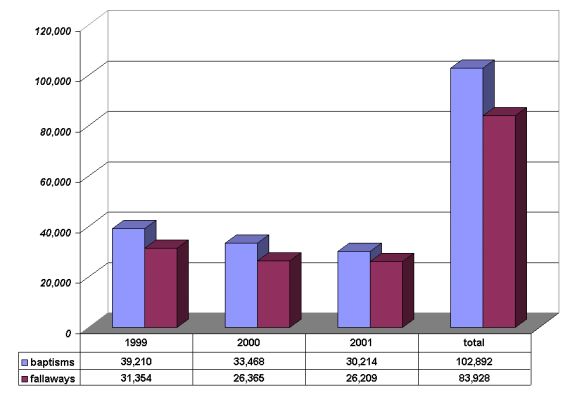
Source: International Churches of Christ, Subtotal by Group Number, 1999, 2000, 2001.
Based on 1999-2001, Baird's "two out of three" estimate needs revision: during 1999-2001, more than four left for every five baptized.
For every 5 people baptized by the ICC in 1999-2001:
... 4.1 people left:
Compounding this mass exit from the ICC is another trend: the ICC's baptism rate actually decreased from 1999-2001 (Figure 1) -- apparently the first time in any three year period the ICC's baptism rate has gone down. This declining trend is even more dramatic on a per-member basis (see Figure 2).
Figure 2: ICC Average Baptisms per Member by Year, 1999-2001
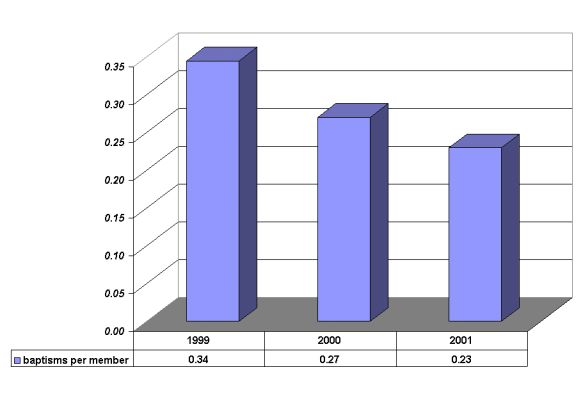
Source: International Churches of Christ, subtotal of baptisms by Group Number, 1999, 2000, 2001 divided by midpoint between "January 1 Disciples" and "Current Disciples" from World Sector Summary, World Report for December 1999, December 2000 and December 2001.
Fewer members joined the ICC in 2000 than in 1999, and fewer members joined in 2001 than 2000 (fallaways declined at a slower rate). There was one baptism for every three ICC members in 1999, but less than one baptism for every four members in 2001. Not surprisingly, these facts have gone unmentioned in the ICC's official propaganda.
The future implication seems clear: the ICC can no longer combat its high fallaway rate with ever-increasing baptisms. Something has to give, and the ICC's very growth seems now in jeopardy.
Another trend obvious from the ICC's 1999-2001 stat sheets is its 2001 stagnation in the First World (The ICC subdivides its statistics between First World, Second World and Third World countries).
ICC First World membership growth in 2001 was essentially flat at 612: almost identical numbers of members joined and left through the "revolving door," resulting in low growth. For a graph comparing the ICC's First World membership growth vs. its growth in the rest of the world, see Figure 3.
Figure 3: ICC Growth by Year -- First World (blue), Second World (red) and Third World (yellow)
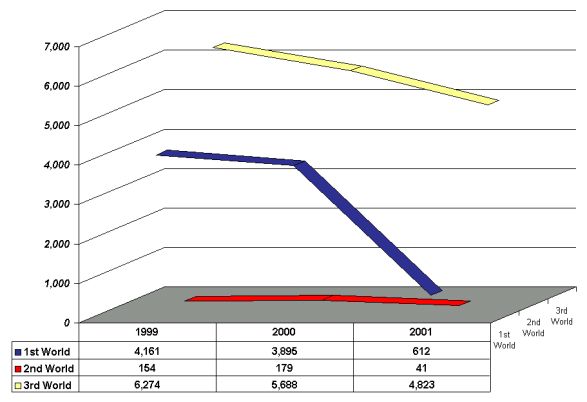
Source: International Churches of Christ, Subtotal of "Increase in Members" by Group Number, 1999, 2000, 2001.
Clearly the ICC is no longer a "multiplying" church in most of the First World, and most of its growth now comes from the Third World.
Nowhere are the ICC's First World Woes more apparent than its largest US churches. Six of the ICC's ten largest US congregations actually shrunk during 2001 -- some of them dramatically (see Figure 4).
Figure 4: ICC Ten Largest US Churches -- 2001 Growth or Loss of Members
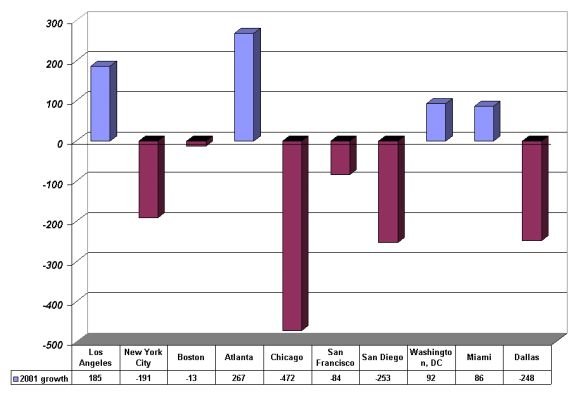
Source: International Churches of Christ, World Report for December 2001 Sorted by WS, Geo Sector and Church.
In 2001 the New York City Church of Christ shrunk by 191 members. The San Diego Church of Christ shrunk by 253. The Chicago Church of Christ shrunk by 472 members. The Dallas Fort Worth International Church of Christ shrunk by 248 (Note that sending mission teams were not the cause of the shortfall for any of these congregations).
As noted on Delphi's ICC Discussion Forum, the Los Angeles International Church of Christ (LAICC) actually boasted becoming the ICC's first 10,000-member church in September 2001, but then fell back to 9,369 members by year's end (up slightly for the year but down more than 600 since October). LAICC baptisms decreased and reported fallaways increased after the announcement of Kip and Elena McKean's sabbatical on November 11.
Retreats from Difficult Territories
In the US and overseas, it seems that the ICC has quietly retreated from some of its difficult mission fields. For instance, in 1995, Al Baird declared, "As of July 1 disciples live and meet in all 50 states of the U.S." (2) But by 1999, the movement did not list a single church in North Dakota. And by the end of 2001, it no longer tracked statistics for its only South Dakota church in Souix Falls after all fifteen of its members moved out. These two US states were missing ICC churches starting 2002, and by official count had no members at all.
Leading up the the mid-2000 completion of the Evangelization Proclamation, the ICC reported church plantings in several "difficult" nations, some of them so hostile to Christianity that stat sheets list cryptic names for them like "Middle East 14" and "Red Dragon 9". Many of these plantings were part of the ICC's lauded "nation countdown" as it attempted to plant a church in every nation with a city over 100,000 people. But by the beginning of 2002, some of these "churches" had shrunk to 1 or 0 members (see Figure 5 - some but not all of these are the only church in their respective nations).
Figure 5: ICC "Churches" with One or Zero Members, End of 2001
ICC Planting Year Planted Dec '01 Members Asmera, Eritrea 1997 1 Belgrade, Yugoslavia 1997 1 Los Palmas, Canary Islands 1997 0 Middle East 12 1998 0 Middle East 14 1996 0 Middle East 16 1996 0 Middle East 17 2000 1 No Cebu 1995 0 Red Dragon 9 1998 0
Source: International Churches of Christ, World Report for December 2001 Sorted by WS, Geo Sector and Church.
Unless the ICC makes 2002 efforts to re-plant some of these congregations, the ICC's "nation countdown" may now be counting in reverse.
The ICC statistics help explain two recent shifts in the church's recruiting focus. Always enterprising in its quest to grow, the ICC seems to be fighting stagnancy by "fishing from its own pond" in two areas: "Kingdom Kids" and restorations.
ICC founder Kip McKean in 1999 said, "We must make baptizing the children of our members a top priority." (4) Since the ICC has an aging core membership, the number of members children is increasing. By the end of 2001, the ICC reported 36,000 "adherents" (apparently children of members). These "Kingdom Kids", as the ICC calls them, have become part of a movement-wide development and recruitment campaign. (The 1999-2001 stat sheets do not show how many of the ICC's baptisms during these years were "Kingdom Kids.")
Not only are members' children a source of ICC baptisms, many of these 36,000 people also help to pad the ICC's attendance stats. While leaders-only stat sheets include a statistic called "% visitors" so that leadership can guage "visitors" besides family, for public consumption, the ICC includes adherents in its attendance numbers.
Another increased focus of the ICC is on "restoring" fallaways -- returning former members to membership in good standing. By 1999, the LA church had begun a Restoration Ministry in response to "thousands of fallaways" there (3). To increase its number of restorations (and minimize fallaways), many congregations have now launched Spiritual Recovery ministries.
Restoring fallaways improves ICC stats: every restoration increases membership by one just like a baptism. And looking at 2001 in particular, without "restorations" the ICC's overall membership growth would have shrunk from 4.3% to 2.3% (see Figure 6).
Figure 6: ICC Growth Percentage by Year, With and Without Restorations
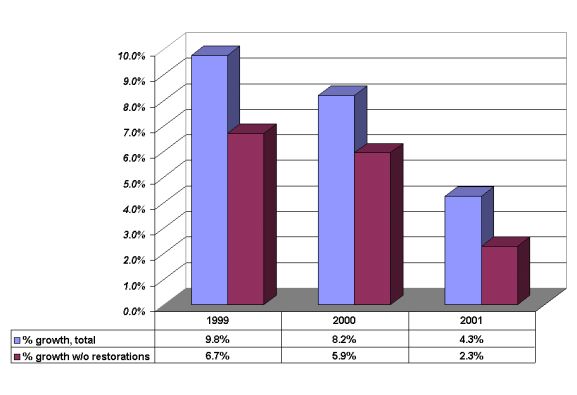
Source/Method: International Churches of Christ, World Sector Summary, World Report for December 1999, December 2000, December 2001 minus total of "restorations" Subtotals by Group Number, 1999, 2000, 2001.
In effect, nearly half of the ICC's 2001 growth came from restorations. Without restorations and the baptism of Kingdom Kids, the ICC might have actually shrunk in 2001.
The 1999-2001 stat sheets provide much information about ICC revenues (although they don't show the details needed to determine the integrity of ICC finances). Because these documents curiously do not show total member contributions (5), we have used the annual weekly average to calculate the ICC's total financial take. One thing is clear: the ICC takes in a lot of money from its members.
Just how much money is shown in Figure 7. Overall, the ICC apparently took in $169 million in 1999, $176 million in 2000 and $183 million in 2001, including weekly and special contributions.
Figure 7: Estimated ICC Global Member Contributions by Year
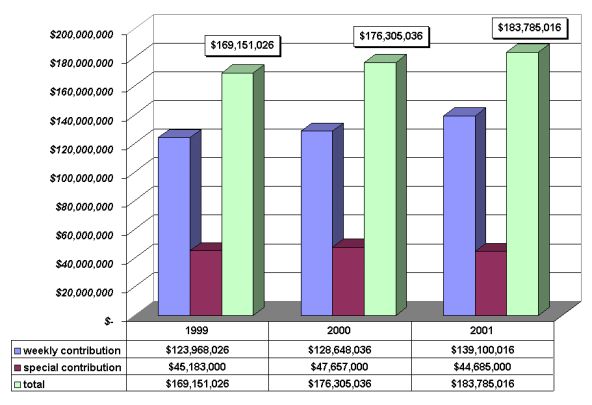
Source/Method: International Churches of Christ, World Report Financial Analysis for December 1999, 2000 & 2001, World Total of "Weekly Actual $" times 52, and "Spec C Actual $."
Even though it apparently took in more money overall from members in 2001 than any previous year, the ICC began laying off staff in some locations. Spokesman Al Baird said the layoffs were because "Low growth meant some tightening of the belt..."
Despite slowing ICC membership growth, members have continued giving lots of money to the organization. On a per-member basis, ICC members in the First World gave an average of $2,400 to $2,500 apiece to their church during these years (see Figure 8), although total ($2,514) and "special" ($691) contributions peaked in 1999.
Figure 8: Projected Annual Contributions per First World ICC Member
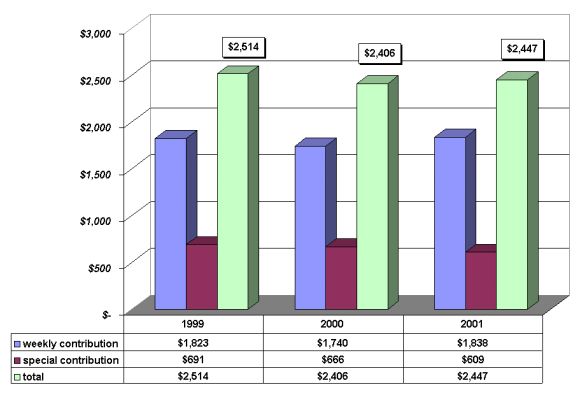
Source/Method: International Churches of Christ, World Report Financial Analysis for December 1999, 2000 & 2001, Group 1 Total of "Weekly Actual $" times 52, and "Spec C Actual $" divided by midpoint between "January 1 Adj" Members and "Dec" Members, Subtotal for Group 1, 1999, 2000, 2001.
ICC members in Second and Third World economies tend to give less money. In fact, this could become a problem for the ICC: with now as many Third World members as First World, supporting its Third World churches could become a greater burden.
The ICC's 1999-2001 statistics show troubling trends for the organization. But why the problems gaining and keeping members?
The ICC's official explanation would would probably be: sin. ICC founder Kip McKean has taught this:
"We need to have a conviction. If our churches are not growing, it's sin. Let me run that by you again: if a church is not growing, it's sin …you've got sin in your church - it's cursed, and you've got to do something about it - are you with me right here?"
Kip McKean, Malachi: God's Radical Demand for Remaining Radical, Manila, DPI Archive Cassette Series, Tape # 9104, 1994.
But with 131 non-growing ICC churches in 2001, how likely that 131 ICC leaders and their congregations suddenly fell "into sin" in 2001? Not very. It would seem more likely that the ICC's methods are catching up with it.
Indeed, the ICC seems to be experiencing a saturation effect: the ICC's easiest territories had already been established, and many of the ICC's congregations have now reached some critical mass of media scrutiny and/or a bad reputation for abuse. Arguably, a flawed system can only be productive for so long.
Another factor seems to be an ICC leadership crisis in many locations and perhaps movement-wide. With 2001 leader changes in some of its largest churches and the puzzling sabbatical of Kip McKean, the ICC has seen its share of upheaval.
We can only hope that these leadership changes -- and even the ICC's desire for better numbers in the future -- will lead to much-needed reform.
[To see the original ICC stats PDF files posted on TOLC website, click here, click here. ]
Related Topics on RightCyberUp.org:
(1) Some former members object to the ICC's term "fallaway," since it implies that everyone who leaves the ICC automatically "falls away" from God.
(2) Al Baird, "Breaking Away - Editorial," LA Story, August 13, 1995, p. 2.
(3) Kip McKean, Singapore Sermon, audio file, February 24, 1999.
(4) Kip McKean, "God's Teen Ministry," LA Story, October 1999, p. 3.
(5) It seems odd that the stats summaries the ICC gives its leaders do not show members' annual weekly contributions. Just about every other statistic includes an annual total, yet weekly contributions are shown only as a weekly average.

Copyright © 2002 Dave Anderson. All rights reserved.